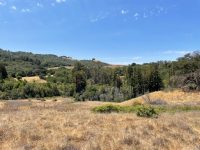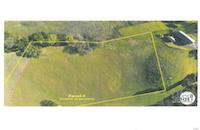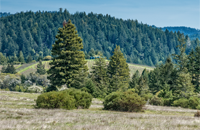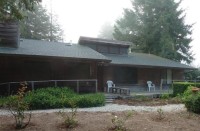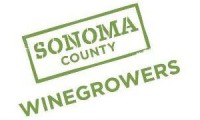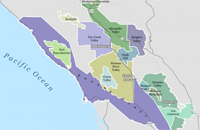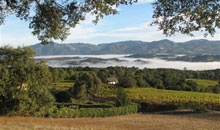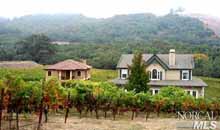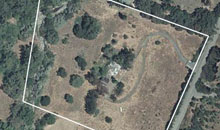
SANTA ROSA, Calif. (August 24, 2015) – Sonoma County’s winegrape growers have voluntarily committed to conserve water by 25% from 2013 levels consistent with the required reductions associated with rural residential water use in the four key water sheds – Mark West Creek, Green Valley Creek, Dutch Bill Creek and Mill Creek. In these four water sheds, there are 130 identified parcels of land with vineyards and in the past four weeks via outreach from the growing community, 68 parcels representing approximately 2,000 acres of land have enrolled in this voluntary water reduction plan.
“I commend Sonoma County’s grape growers for leading by example with their voluntary 25 percent water reduction along these critical water sheds, as well as their forward thinking in collaborating with the business community, local government, and water agencies to help educate the public about ways to conserve water,” says Sonoma County Supervisor James Gore. “During this time of severe drought conditions, everyone in our community needs to do their part to help conserve water.”
The voluntary drought program includes water conservation and best management practices for water use in their vineyards. This is the latest effort by local winegrape growers to minimize their water use in response to the ongoing drought and collaborate with the rural residents, with everyone doing their part in these extreme times.
Over the past two years, Sonoma County Winegrowers have hosted dozens of meetings to educate grape growers on water conservation best practices and the latest vineyard innovations. These grower meetings also including leading experts, scientists, and others who educated farmers on ways to monitor and conserve water. More recently, the Sonoma County Winegrowers began collaborating with the local business community, regional water agencies and the State Water Resources Control Board to create a unique public/private partnership known as the North Bay Water Sustainability Coalition to help inform and educate the public about water conservation. As part of this effort, the Sonoma County Winegrowers began holding meetings in July to recruit vineyard owners along the watersheds to commit to these voluntary water use cuts.
“We all have a stake in preserving these water sheds. Water is our most precious resource in Sonoma County which is why the grape growing community has spent years developing new water saving technology to conserve water in our vineyards,” said Karissa Kruse, president of the Sonoma County Winegrowers. She added, “This commitment to water conservation is possible because of our winegrowing sustainability program and the wealth of best management practices available to participating farmers to minimize water use and maximize its benefits.”
Sonoma County’s winegrowers have been collaborating with scientists, researchers and leading universities over the past couple of decades to develop new technologies and innovations that are commonly found in most, if not all, local vineyards. These include drip irrigation, soil moisture probes, weather stations and evapotranspiration monitors to put a precise amount of water exactly where it is needed when it is needed most.
Joe Dutton, a fifth-generation farmer, has been instrumental in working with his local neighboring farms to share ideas and practices so growers can be more water efficient. He has also played a leading role in the voluntary drought initiative.
“Our family has been farming in Sonoma County since the late 1800’s and we hope to continue farming for centuries to come,” said Joe Dutton. He added, “We are proud to sign this voluntary water reduction pledge because it is important to our family to be good neighbor and preserve the land, the watersheds and the natural habitat that makes Sonoma County so special to all who live here.”
Grapes are one of the most efficient crops for water use. A normal weather year results in 25 – 60 inches of rainfall in the County’s winegrape growing areas. Grape irrigation uses only 3-6 inches per year in Sonoma County so that remaining water accumulated in the rainy season goes back into the ground and recharges the aquifer.
Sonoma County has some of the world’s most prized grape growing areas in the world with the first vineyards dating back to the 1820s. The region’s unique combination of rich geological history, fog patterns generated by its 70-mile Pacific Ocean coastline, and topography offers distinct climates, soils and temperature areas perfect for growing world-class Pinot Noir, Chardonnay, Cabernet Sauvignon, Zinfandel and more. Sonoma County is also home to around 500 wineries whose wines are renowned throughout the world. The local wine industry accounts for providing 54,297 full-time equivalent jobs, directly and indirectly, from winegrowing and winemaking in Sonoma County.
About Sonoma County Winegrowers:
The Sonoma County Winegrape Commission, also known as Sonoma County Winegrowers (SCW), is a marketing and education organization dedicated to the promotion and preservation of Sonoma County as one of the world’s premier grape growing regions. SCW has oversight by the California Department of Food and Agriculture and seeks to increase awareness and recognition of the quality and diversity of Sonoma County’s grapes and wines through dynamic marketing and educational programs targeted to wine consumers around the world. In January 2014, SCW committed to becoming the nation’s first 100% sustainable winegrowing region by 2019. For more information about SCW and its programs, visit www.sonomawinegrape.org

